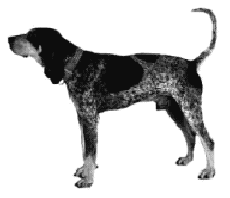Bluetick Coonhound
A breed standard is the guideline which describes the ideal characteristics, temperament, and appearance of a breed and ensures that the breed is fit for function with soundness essential. Breeders and judges should at all times be careful to avoid obvious conditions and exaggerations, as well as being mindful of features which could be detrimental in any way to the health, welfare or soundness of this breed.
Breed Standard - Bluetick Coonhound

The modern Bluetick’s colour indicates that it descended from the Grand Bleu de Gascogne (French Staghound) as well as the English Foxhound. Many French hounds were brought to America and contributed to the coonhound breeds. One owned by George Washington was recorded as giving birth to 15 puppies, and Washington likened their musical voices to the “bells of Moscow”. The Grand Bleu was too slow on the trail to please the American hunter but, when bred to American hounds, it increased their coldtrailing ability and their endurance.
Although Blueticks were originally classified as English Coonhounds, Bluetick breeders broke away from the English breeders in 1945 because they didn’t want to follow the trend toward producing a hot-nosed, faster hunter. Proud of their larger, cold-nosed and resolute, if slower hounds, they named their breed and maintained their own hunting style. For a short time, puppies with blue ticking were classified as Blueticks and those with red ticking were still called English. But that practice soon ceased as each Coonhound maintained its own group of staunch supporters.
An intelligent, cold:nosed hunter that trees hard and long, the Bluetick has the ability and endurance to stay on the most intricate track. He is free tonguer on the trail with a medium bawl or bugle voice when striking and trailing. The changes to a steady chop when running and a steady course chop at tree.
Official Standard
General Appearance: Strong, deep:chested and sturdy with a houndy expression and longish ears, the Bluetick combines power with agility and endurance. An intelligent, cold:nosed, honest hunter that trees hard and long, his overall aspect is kind and self:assured.
Size, Proportion, Substance: Males 61 cm to 76 cm (24 to 30 inches) at withers; Females 58 to 71 cm (23 to 28 inches) at the withers.
Very Serious Fault: Undersized. Proportion: Somewhat rectangular. Length slightly longer than height. Substance: Weight Males 25 kg to 45.4 kg (55 to 100 lbs). Females 20.4 kg to 38.6 kg (45 to 85 lbs).
Head
Expression: Pleasantly pleading.
Eyes: Almost round, dark brown.
Fault: Deep set.
Very Serious fault: Light coloured eyes.
Lids: Firm and close.
Fault: Sagging lids.
Ears: Set below top of skull. Thin and Tapered at ends. Extend almost to end of nose when drawn out. No erectile motion.
Skull: Domed and broad between the ears.
Muzzle: Square, well proportioned with the width of the skull.
Bite: Scissors.
Fault: Overshot or undershot.
Neck, Topline and Body
Neck: The neck is muscular with minimum dewlap. In proportion to body length. The topline is higher at the withers than at hips.
Chest: Large, very deep. Girth for adult males 66 cm to 89 cm (26 to 35 inches). Adult females 58 to 81 cm (23 to 32 inches).
Ribs: Well sprung with good depth. Tapered gradually to floating ribs.
Back: Moderate length, muscular.
Fault: Swayed or roached.
Loins: Muscular, broad, slightly arched.
Fault: Narrowness at loins.
Tail: Medium length, attached slightly below the back line, carried high in a sabre:like curve. Well coated.
Fault: Plume or rat tail.
Forequarters
Shoulders: Powerfully constructed, muscular, gradually tapering down from withers, free moving.
Forelegs: Straight, muscular, with a strong straight pastern. Appear straight from either side or front view.
Feet: Deep padded, round, arched toes, cat:like when standing.
Hindquarters
Legs: Hind legs appear straight when viewed from behind, turning neither in or out.
Thighs: Upper and lower thighs muscled, curved at stifle, gradually tapering down to hocks.
Hock Joints: moderately bent.
Fault: Excessively bent at hock joints.
Hocks: Firm.
Fault: Hind dewclaws.
Coat: Medium course, rather short, laying close to the body. Smooth and glossy.
Colour: Dark blue, mottled, spotted by various shaped black spots on back, ears and side. More blue than black preferred. Tan dots over eyes and on cheeks with dark red ticking on feet, lower legs below body line, chest and below tail. Absence of tan on head and body and absence of black spots are permissible. Blueticking should dominate over white in the body coat.
Very Serious Fault: Off colours.
Gait: Steady, determined, ground:covering stride, exhibiting reach and drive.
Temperament: Intelligent, pleasing. An equally fine companion for a day at home or a night of hunting.
Serious Faults
: Undersized, light:coloured eyes, off colours.
Note: Male animals should have two apparently normal testicles fully descended into the scrotum.
DNZ No 421
Copyright Dogs New Zealand
01 Mar 2006
Any departure from the foregoing points should be considered a fault and the seriousness with which the fault should be regarded should be in exact proportion to its degree and its effect upon the health and welfare of the dog and on the dog’s ability to perform its traditional work.




